Green Logistics: Techniques, Impact, Barriers, and Advantages
VerifiedAdded on 2023/04/21
|9
|2440
|383
AI Summary
This research explores the techniques, impact, barriers, and advantages of green logistics, specifically focusing on reverse logistics. It discusses how reverse logistics promotes energy saving, product revaluation, recycling, and safe disposal. The research aims to provide practical and theoretical implications for organizations and recommends suitable techniques to enhance reverse logistics.
Contribute Materials
Your contribution can guide someone’s learning journey. Share your
documents today.

GREEN LOGISTICS 1
GREEN LOGISTICS
Student’s Name
Professor’s Name
Institution
Course
Date
GREEN LOGISTICS
Student’s Name
Professor’s Name
Institution
Course
Date
Secure Best Marks with AI Grader
Need help grading? Try our AI Grader for instant feedback on your assignments.
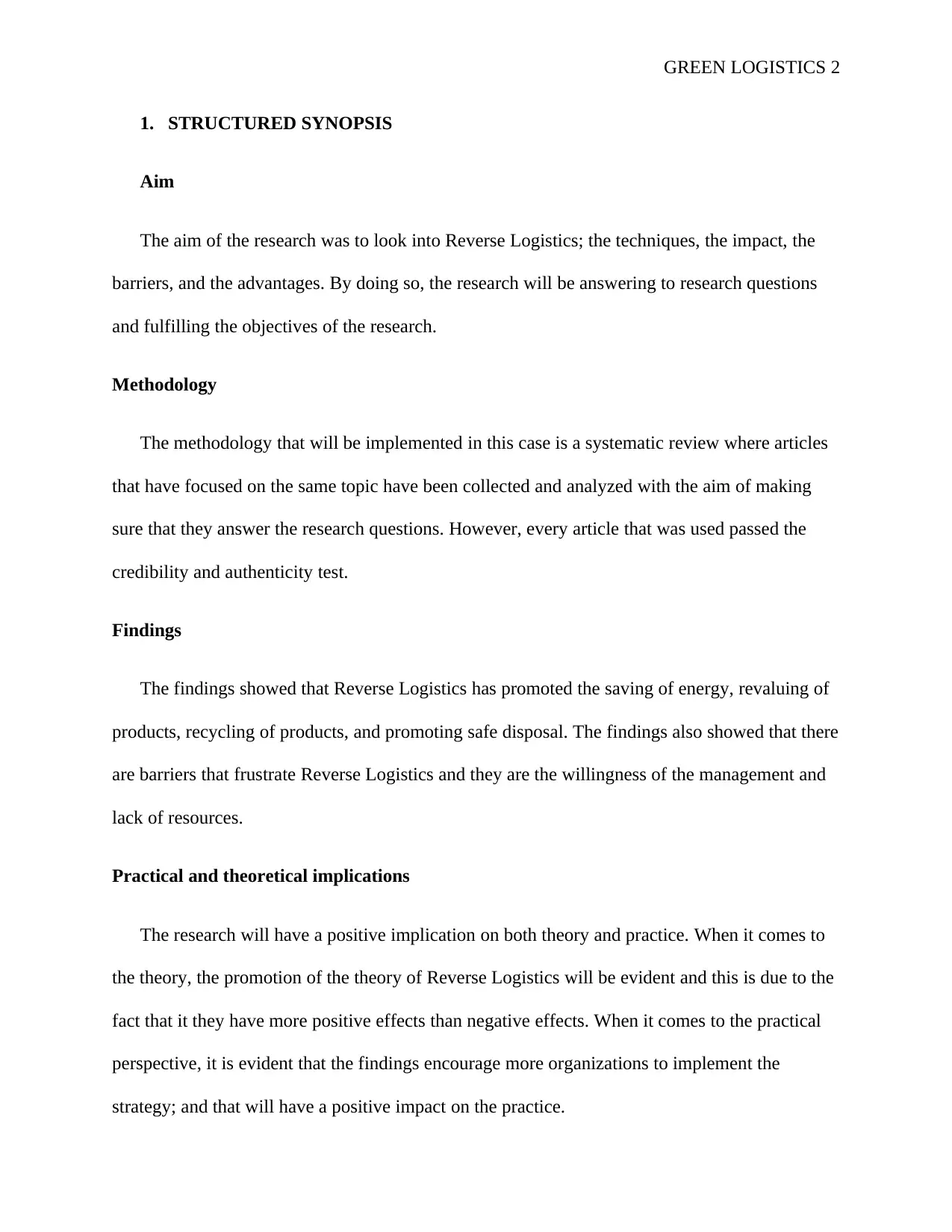
GREEN LOGISTICS 2
1. STRUCTURED SYNOPSIS
Aim
The aim of the research was to look into Reverse Logistics; the techniques, the impact, the
barriers, and the advantages. By doing so, the research will be answering to research questions
and fulfilling the objectives of the research.
Methodology
The methodology that will be implemented in this case is a systematic review where articles
that have focused on the same topic have been collected and analyzed with the aim of making
sure that they answer the research questions. However, every article that was used passed the
credibility and authenticity test.
Findings
The findings showed that Reverse Logistics has promoted the saving of energy, revaluing of
products, recycling of products, and promoting safe disposal. The findings also showed that there
are barriers that frustrate Reverse Logistics and they are the willingness of the management and
lack of resources.
Practical and theoretical implications
The research will have a positive implication on both theory and practice. When it comes to
the theory, the promotion of the theory of Reverse Logistics will be evident and this is due to the
fact that it they have more positive effects than negative effects. When it comes to the practical
perspective, it is evident that the findings encourage more organizations to implement the
strategy; and that will have a positive impact on the practice.
1. STRUCTURED SYNOPSIS
Aim
The aim of the research was to look into Reverse Logistics; the techniques, the impact, the
barriers, and the advantages. By doing so, the research will be answering to research questions
and fulfilling the objectives of the research.
Methodology
The methodology that will be implemented in this case is a systematic review where articles
that have focused on the same topic have been collected and analyzed with the aim of making
sure that they answer the research questions. However, every article that was used passed the
credibility and authenticity test.
Findings
The findings showed that Reverse Logistics has promoted the saving of energy, revaluing of
products, recycling of products, and promoting safe disposal. The findings also showed that there
are barriers that frustrate Reverse Logistics and they are the willingness of the management and
lack of resources.
Practical and theoretical implications
The research will have a positive implication on both theory and practice. When it comes to
the theory, the promotion of the theory of Reverse Logistics will be evident and this is due to the
fact that it they have more positive effects than negative effects. When it comes to the practical
perspective, it is evident that the findings encourage more organizations to implement the
strategy; and that will have a positive impact on the practice.
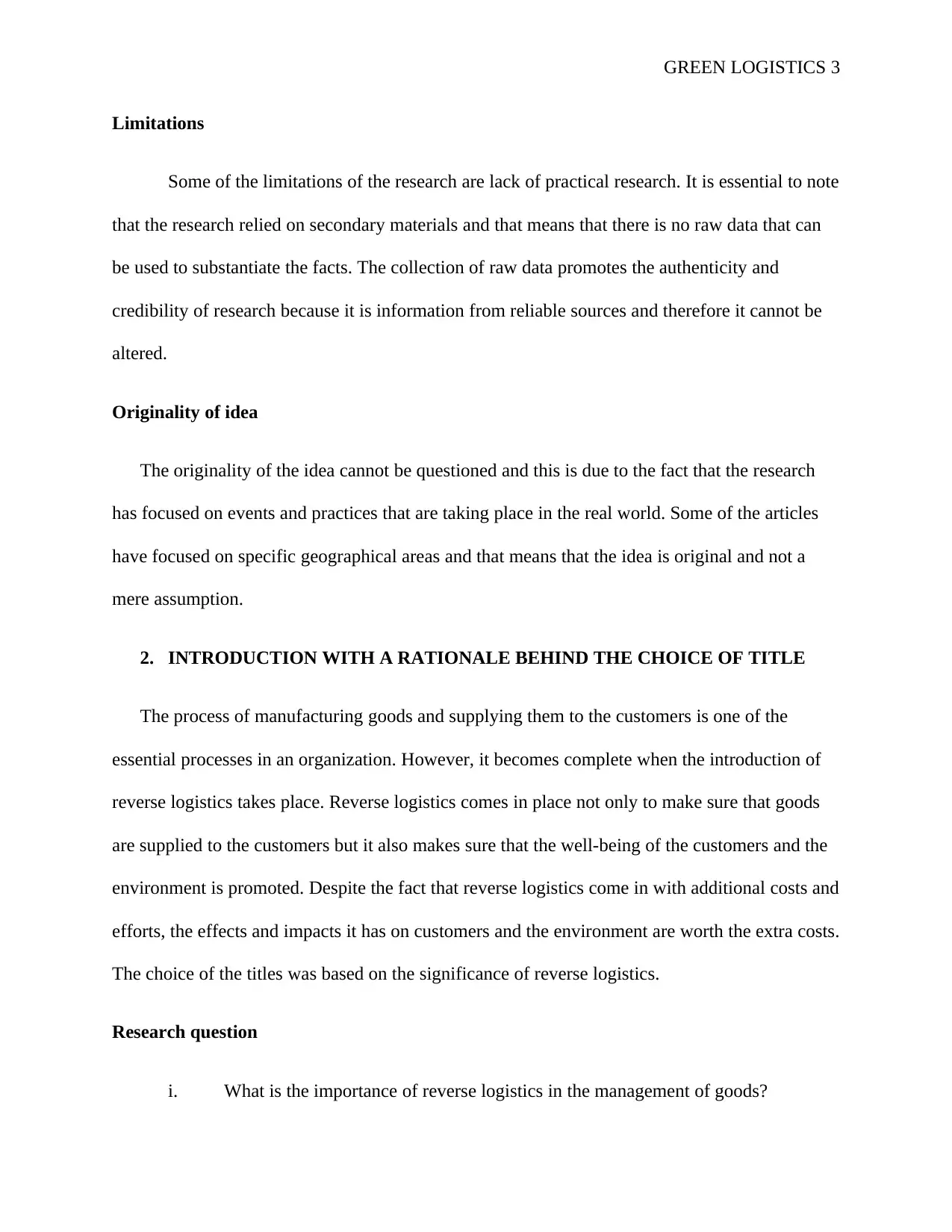
GREEN LOGISTICS 3
Limitations
Some of the limitations of the research are lack of practical research. It is essential to note
that the research relied on secondary materials and that means that there is no raw data that can
be used to substantiate the facts. The collection of raw data promotes the authenticity and
credibility of research because it is information from reliable sources and therefore it cannot be
altered.
Originality of idea
The originality of the idea cannot be questioned and this is due to the fact that the research
has focused on events and practices that are taking place in the real world. Some of the articles
have focused on specific geographical areas and that means that the idea is original and not a
mere assumption.
2. INTRODUCTION WITH A RATIONALE BEHIND THE CHOICE OF TITLE
The process of manufacturing goods and supplying them to the customers is one of the
essential processes in an organization. However, it becomes complete when the introduction of
reverse logistics takes place. Reverse logistics comes in place not only to make sure that goods
are supplied to the customers but it also makes sure that the well-being of the customers and the
environment is promoted. Despite the fact that reverse logistics come in with additional costs and
efforts, the effects and impacts it has on customers and the environment are worth the extra costs.
The choice of the titles was based on the significance of reverse logistics.
Research question
i. What is the importance of reverse logistics in the management of goods?
Limitations
Some of the limitations of the research are lack of practical research. It is essential to note
that the research relied on secondary materials and that means that there is no raw data that can
be used to substantiate the facts. The collection of raw data promotes the authenticity and
credibility of research because it is information from reliable sources and therefore it cannot be
altered.
Originality of idea
The originality of the idea cannot be questioned and this is due to the fact that the research
has focused on events and practices that are taking place in the real world. Some of the articles
have focused on specific geographical areas and that means that the idea is original and not a
mere assumption.
2. INTRODUCTION WITH A RATIONALE BEHIND THE CHOICE OF TITLE
The process of manufacturing goods and supplying them to the customers is one of the
essential processes in an organization. However, it becomes complete when the introduction of
reverse logistics takes place. Reverse logistics comes in place not only to make sure that goods
are supplied to the customers but it also makes sure that the well-being of the customers and the
environment is promoted. Despite the fact that reverse logistics come in with additional costs and
efforts, the effects and impacts it has on customers and the environment are worth the extra costs.
The choice of the titles was based on the significance of reverse logistics.
Research question
i. What is the importance of reverse logistics in the management of goods?
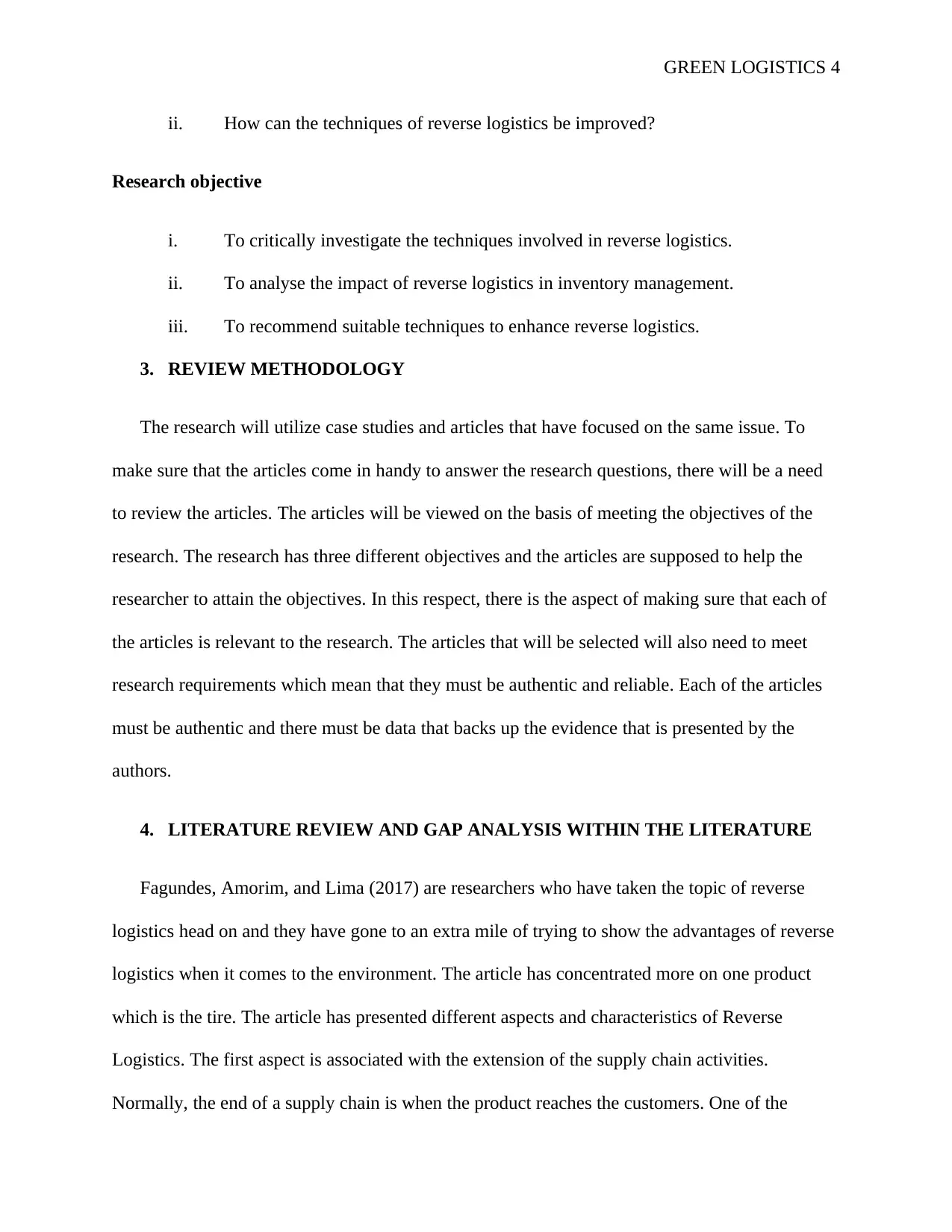
GREEN LOGISTICS 4
ii. How can the techniques of reverse logistics be improved?
Research objective
i. To critically investigate the techniques involved in reverse logistics.
ii. To analyse the impact of reverse logistics in inventory management.
iii. To recommend suitable techniques to enhance reverse logistics.
3. REVIEW METHODOLOGY
The research will utilize case studies and articles that have focused on the same issue. To
make sure that the articles come in handy to answer the research questions, there will be a need
to review the articles. The articles will be viewed on the basis of meeting the objectives of the
research. The research has three different objectives and the articles are supposed to help the
researcher to attain the objectives. In this respect, there is the aspect of making sure that each of
the articles is relevant to the research. The articles that will be selected will also need to meet
research requirements which mean that they must be authentic and reliable. Each of the articles
must be authentic and there must be data that backs up the evidence that is presented by the
authors.
4. LITERATURE REVIEW AND GAP ANALYSIS WITHIN THE LITERATURE
Fagundes, Amorim, and Lima (2017) are researchers who have taken the topic of reverse
logistics head on and they have gone to an extra mile of trying to show the advantages of reverse
logistics when it comes to the environment. The article has concentrated more on one product
which is the tire. The article has presented different aspects and characteristics of Reverse
Logistics. The first aspect is associated with the extension of the supply chain activities.
Normally, the end of a supply chain is when the product reaches the customers. One of the
ii. How can the techniques of reverse logistics be improved?
Research objective
i. To critically investigate the techniques involved in reverse logistics.
ii. To analyse the impact of reverse logistics in inventory management.
iii. To recommend suitable techniques to enhance reverse logistics.
3. REVIEW METHODOLOGY
The research will utilize case studies and articles that have focused on the same issue. To
make sure that the articles come in handy to answer the research questions, there will be a need
to review the articles. The articles will be viewed on the basis of meeting the objectives of the
research. The research has three different objectives and the articles are supposed to help the
researcher to attain the objectives. In this respect, there is the aspect of making sure that each of
the articles is relevant to the research. The articles that will be selected will also need to meet
research requirements which mean that they must be authentic and reliable. Each of the articles
must be authentic and there must be data that backs up the evidence that is presented by the
authors.
4. LITERATURE REVIEW AND GAP ANALYSIS WITHIN THE LITERATURE
Fagundes, Amorim, and Lima (2017) are researchers who have taken the topic of reverse
logistics head on and they have gone to an extra mile of trying to show the advantages of reverse
logistics when it comes to the environment. The article has concentrated more on one product
which is the tire. The article has presented different aspects and characteristics of Reverse
Logistics. The first aspect is associated with the extension of the supply chain activities.
Normally, the end of a supply chain is when the product reaches the customers. One of the
Secure Best Marks with AI Grader
Need help grading? Try our AI Grader for instant feedback on your assignments.
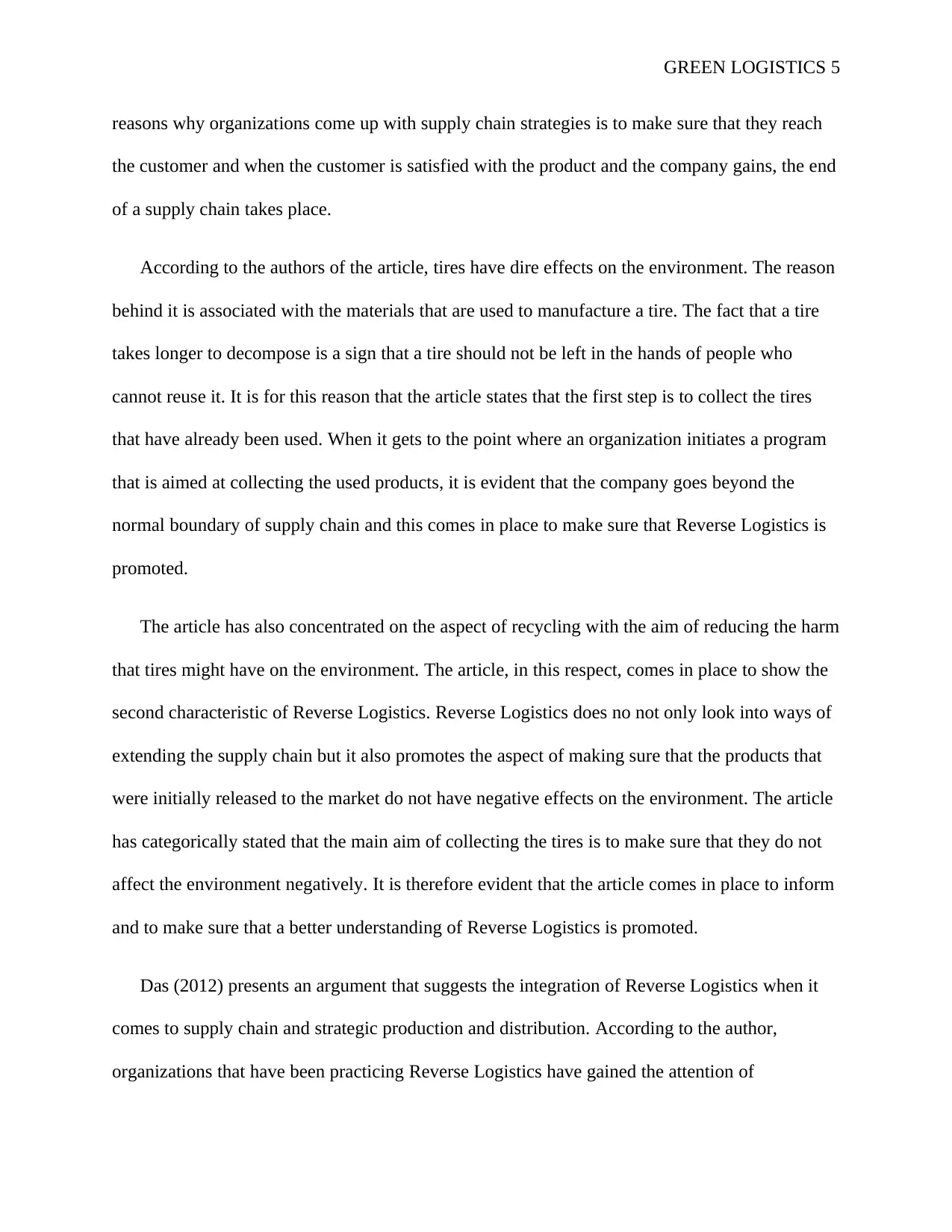
GREEN LOGISTICS 5
reasons why organizations come up with supply chain strategies is to make sure that they reach
the customer and when the customer is satisfied with the product and the company gains, the end
of a supply chain takes place.
According to the authors of the article, tires have dire effects on the environment. The reason
behind it is associated with the materials that are used to manufacture a tire. The fact that a tire
takes longer to decompose is a sign that a tire should not be left in the hands of people who
cannot reuse it. It is for this reason that the article states that the first step is to collect the tires
that have already been used. When it gets to the point where an organization initiates a program
that is aimed at collecting the used products, it is evident that the company goes beyond the
normal boundary of supply chain and this comes in place to make sure that Reverse Logistics is
promoted.
The article has also concentrated on the aspect of recycling with the aim of reducing the harm
that tires might have on the environment. The article, in this respect, comes in place to show the
second characteristic of Reverse Logistics. Reverse Logistics does no not only look into ways of
extending the supply chain but it also promotes the aspect of making sure that the products that
were initially released to the market do not have negative effects on the environment. The article
has categorically stated that the main aim of collecting the tires is to make sure that they do not
affect the environment negatively. It is therefore evident that the article comes in place to inform
and to make sure that a better understanding of Reverse Logistics is promoted.
Das (2012) presents an argument that suggests the integration of Reverse Logistics when it
comes to supply chain and strategic production and distribution. According to the author,
organizations that have been practicing Reverse Logistics have gained the attention of
reasons why organizations come up with supply chain strategies is to make sure that they reach
the customer and when the customer is satisfied with the product and the company gains, the end
of a supply chain takes place.
According to the authors of the article, tires have dire effects on the environment. The reason
behind it is associated with the materials that are used to manufacture a tire. The fact that a tire
takes longer to decompose is a sign that a tire should not be left in the hands of people who
cannot reuse it. It is for this reason that the article states that the first step is to collect the tires
that have already been used. When it gets to the point where an organization initiates a program
that is aimed at collecting the used products, it is evident that the company goes beyond the
normal boundary of supply chain and this comes in place to make sure that Reverse Logistics is
promoted.
The article has also concentrated on the aspect of recycling with the aim of reducing the harm
that tires might have on the environment. The article, in this respect, comes in place to show the
second characteristic of Reverse Logistics. Reverse Logistics does no not only look into ways of
extending the supply chain but it also promotes the aspect of making sure that the products that
were initially released to the market do not have negative effects on the environment. The article
has categorically stated that the main aim of collecting the tires is to make sure that they do not
affect the environment negatively. It is therefore evident that the article comes in place to inform
and to make sure that a better understanding of Reverse Logistics is promoted.
Das (2012) presents an argument that suggests the integration of Reverse Logistics when it
comes to supply chain and strategic production and distribution. According to the author,
organizations that have been practicing Reverse Logistics have gained the attention of
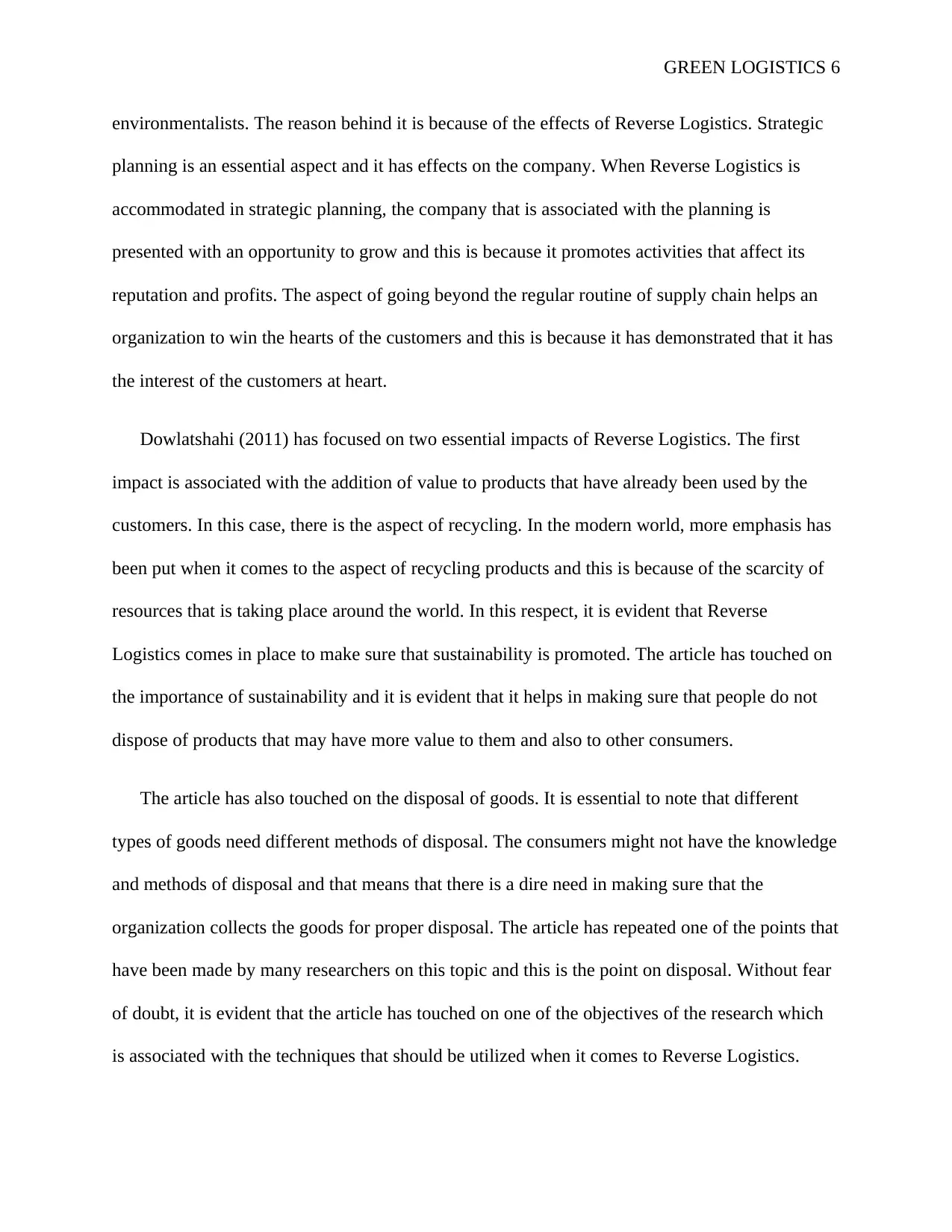
GREEN LOGISTICS 6
environmentalists. The reason behind it is because of the effects of Reverse Logistics. Strategic
planning is an essential aspect and it has effects on the company. When Reverse Logistics is
accommodated in strategic planning, the company that is associated with the planning is
presented with an opportunity to grow and this is because it promotes activities that affect its
reputation and profits. The aspect of going beyond the regular routine of supply chain helps an
organization to win the hearts of the customers and this is because it has demonstrated that it has
the interest of the customers at heart.
Dowlatshahi (2011) has focused on two essential impacts of Reverse Logistics. The first
impact is associated with the addition of value to products that have already been used by the
customers. In this case, there is the aspect of recycling. In the modern world, more emphasis has
been put when it comes to the aspect of recycling products and this is because of the scarcity of
resources that is taking place around the world. In this respect, it is evident that Reverse
Logistics comes in place to make sure that sustainability is promoted. The article has touched on
the importance of sustainability and it is evident that it helps in making sure that people do not
dispose of products that may have more value to them and also to other consumers.
The article has also touched on the disposal of goods. It is essential to note that different
types of goods need different methods of disposal. The consumers might not have the knowledge
and methods of disposal and that means that there is a dire need in making sure that the
organization collects the goods for proper disposal. The article has repeated one of the points that
have been made by many researchers on this topic and this is the point on disposal. Without fear
of doubt, it is evident that the article has touched on one of the objectives of the research which
is associated with the techniques that should be utilized when it comes to Reverse Logistics.
environmentalists. The reason behind it is because of the effects of Reverse Logistics. Strategic
planning is an essential aspect and it has effects on the company. When Reverse Logistics is
accommodated in strategic planning, the company that is associated with the planning is
presented with an opportunity to grow and this is because it promotes activities that affect its
reputation and profits. The aspect of going beyond the regular routine of supply chain helps an
organization to win the hearts of the customers and this is because it has demonstrated that it has
the interest of the customers at heart.
Dowlatshahi (2011) has focused on two essential impacts of Reverse Logistics. The first
impact is associated with the addition of value to products that have already been used by the
customers. In this case, there is the aspect of recycling. In the modern world, more emphasis has
been put when it comes to the aspect of recycling products and this is because of the scarcity of
resources that is taking place around the world. In this respect, it is evident that Reverse
Logistics comes in place to make sure that sustainability is promoted. The article has touched on
the importance of sustainability and it is evident that it helps in making sure that people do not
dispose of products that may have more value to them and also to other consumers.
The article has also touched on the disposal of goods. It is essential to note that different
types of goods need different methods of disposal. The consumers might not have the knowledge
and methods of disposal and that means that there is a dire need in making sure that the
organization collects the goods for proper disposal. The article has repeated one of the points that
have been made by many researchers on this topic and this is the point on disposal. Without fear
of doubt, it is evident that the article has touched on one of the objectives of the research which
is associated with the techniques that should be utilized when it comes to Reverse Logistics.
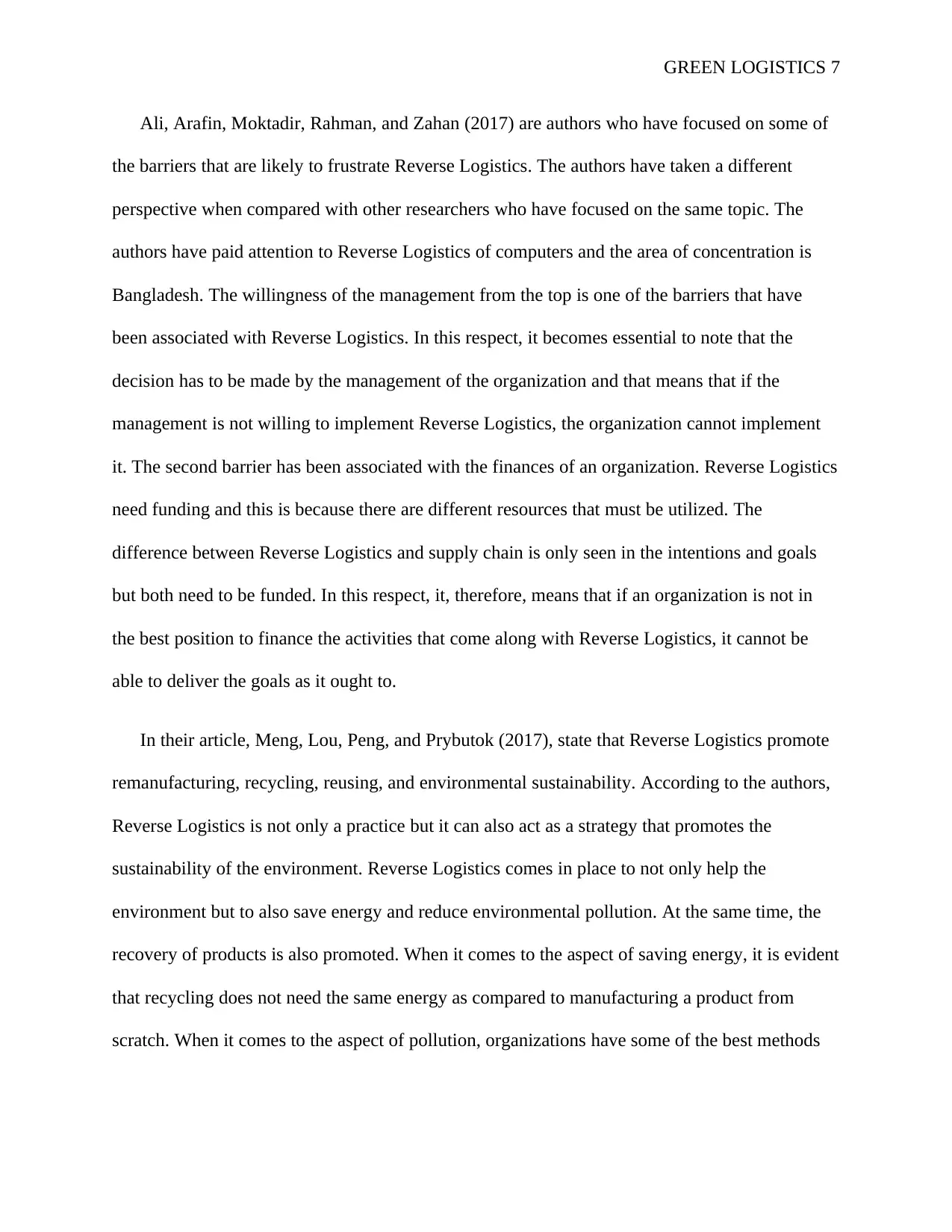
GREEN LOGISTICS 7
Ali, Arafin, Moktadir, Rahman, and Zahan (2017) are authors who have focused on some of
the barriers that are likely to frustrate Reverse Logistics. The authors have taken a different
perspective when compared with other researchers who have focused on the same topic. The
authors have paid attention to Reverse Logistics of computers and the area of concentration is
Bangladesh. The willingness of the management from the top is one of the barriers that have
been associated with Reverse Logistics. In this respect, it becomes essential to note that the
decision has to be made by the management of the organization and that means that if the
management is not willing to implement Reverse Logistics, the organization cannot implement
it. The second barrier has been associated with the finances of an organization. Reverse Logistics
need funding and this is because there are different resources that must be utilized. The
difference between Reverse Logistics and supply chain is only seen in the intentions and goals
but both need to be funded. In this respect, it, therefore, means that if an organization is not in
the best position to finance the activities that come along with Reverse Logistics, it cannot be
able to deliver the goals as it ought to.
In their article, Meng, Lou, Peng, and Prybutok (2017), state that Reverse Logistics promote
remanufacturing, recycling, reusing, and environmental sustainability. According to the authors,
Reverse Logistics is not only a practice but it can also act as a strategy that promotes the
sustainability of the environment. Reverse Logistics comes in place to not only help the
environment but to also save energy and reduce environmental pollution. At the same time, the
recovery of products is also promoted. When it comes to the aspect of saving energy, it is evident
that recycling does not need the same energy as compared to manufacturing a product from
scratch. When it comes to the aspect of pollution, organizations have some of the best methods
Ali, Arafin, Moktadir, Rahman, and Zahan (2017) are authors who have focused on some of
the barriers that are likely to frustrate Reverse Logistics. The authors have taken a different
perspective when compared with other researchers who have focused on the same topic. The
authors have paid attention to Reverse Logistics of computers and the area of concentration is
Bangladesh. The willingness of the management from the top is one of the barriers that have
been associated with Reverse Logistics. In this respect, it becomes essential to note that the
decision has to be made by the management of the organization and that means that if the
management is not willing to implement Reverse Logistics, the organization cannot implement
it. The second barrier has been associated with the finances of an organization. Reverse Logistics
need funding and this is because there are different resources that must be utilized. The
difference between Reverse Logistics and supply chain is only seen in the intentions and goals
but both need to be funded. In this respect, it, therefore, means that if an organization is not in
the best position to finance the activities that come along with Reverse Logistics, it cannot be
able to deliver the goals as it ought to.
In their article, Meng, Lou, Peng, and Prybutok (2017), state that Reverse Logistics promote
remanufacturing, recycling, reusing, and environmental sustainability. According to the authors,
Reverse Logistics is not only a practice but it can also act as a strategy that promotes the
sustainability of the environment. Reverse Logistics comes in place to not only help the
environment but to also save energy and reduce environmental pollution. At the same time, the
recovery of products is also promoted. When it comes to the aspect of saving energy, it is evident
that recycling does not need the same energy as compared to manufacturing a product from
scratch. When it comes to the aspect of pollution, organizations have some of the best methods
Paraphrase This Document
Need a fresh take? Get an instant paraphrase of this document with our AI Paraphraser
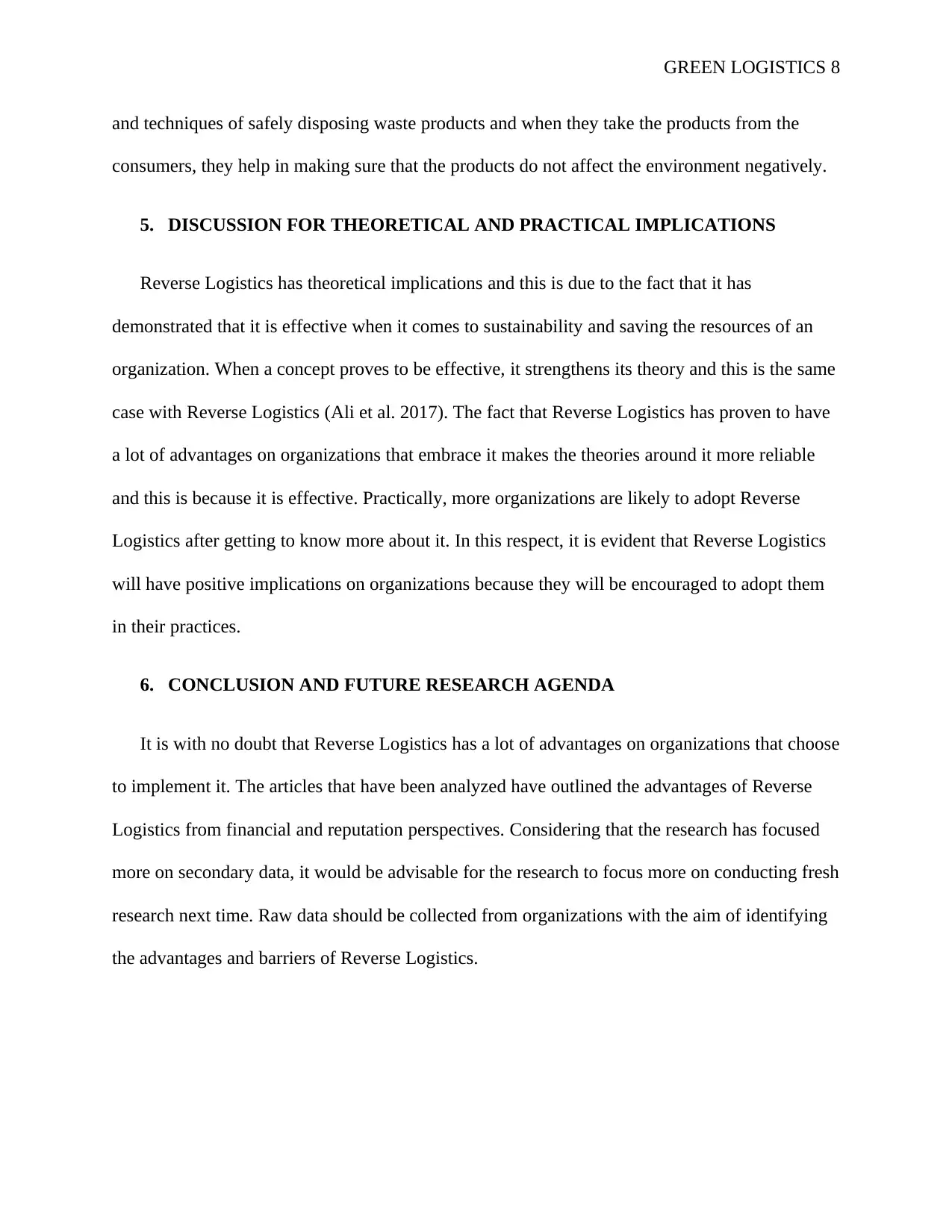
GREEN LOGISTICS 8
and techniques of safely disposing waste products and when they take the products from the
consumers, they help in making sure that the products do not affect the environment negatively.
5. DISCUSSION FOR THEORETICAL AND PRACTICAL IMPLICATIONS
Reverse Logistics has theoretical implications and this is due to the fact that it has
demonstrated that it is effective when it comes to sustainability and saving the resources of an
organization. When a concept proves to be effective, it strengthens its theory and this is the same
case with Reverse Logistics (Ali et al. 2017). The fact that Reverse Logistics has proven to have
a lot of advantages on organizations that embrace it makes the theories around it more reliable
and this is because it is effective. Practically, more organizations are likely to adopt Reverse
Logistics after getting to know more about it. In this respect, it is evident that Reverse Logistics
will have positive implications on organizations because they will be encouraged to adopt them
in their practices.
6. CONCLUSION AND FUTURE RESEARCH AGENDA
It is with no doubt that Reverse Logistics has a lot of advantages on organizations that choose
to implement it. The articles that have been analyzed have outlined the advantages of Reverse
Logistics from financial and reputation perspectives. Considering that the research has focused
more on secondary data, it would be advisable for the research to focus more on conducting fresh
research next time. Raw data should be collected from organizations with the aim of identifying
the advantages and barriers of Reverse Logistics.
and techniques of safely disposing waste products and when they take the products from the
consumers, they help in making sure that the products do not affect the environment negatively.
5. DISCUSSION FOR THEORETICAL AND PRACTICAL IMPLICATIONS
Reverse Logistics has theoretical implications and this is due to the fact that it has
demonstrated that it is effective when it comes to sustainability and saving the resources of an
organization. When a concept proves to be effective, it strengthens its theory and this is the same
case with Reverse Logistics (Ali et al. 2017). The fact that Reverse Logistics has proven to have
a lot of advantages on organizations that embrace it makes the theories around it more reliable
and this is because it is effective. Practically, more organizations are likely to adopt Reverse
Logistics after getting to know more about it. In this respect, it is evident that Reverse Logistics
will have positive implications on organizations because they will be encouraged to adopt them
in their practices.
6. CONCLUSION AND FUTURE RESEARCH AGENDA
It is with no doubt that Reverse Logistics has a lot of advantages on organizations that choose
to implement it. The articles that have been analyzed have outlined the advantages of Reverse
Logistics from financial and reputation perspectives. Considering that the research has focused
more on secondary data, it would be advisable for the research to focus more on conducting fresh
research next time. Raw data should be collected from organizations with the aim of identifying
the advantages and barriers of Reverse Logistics.
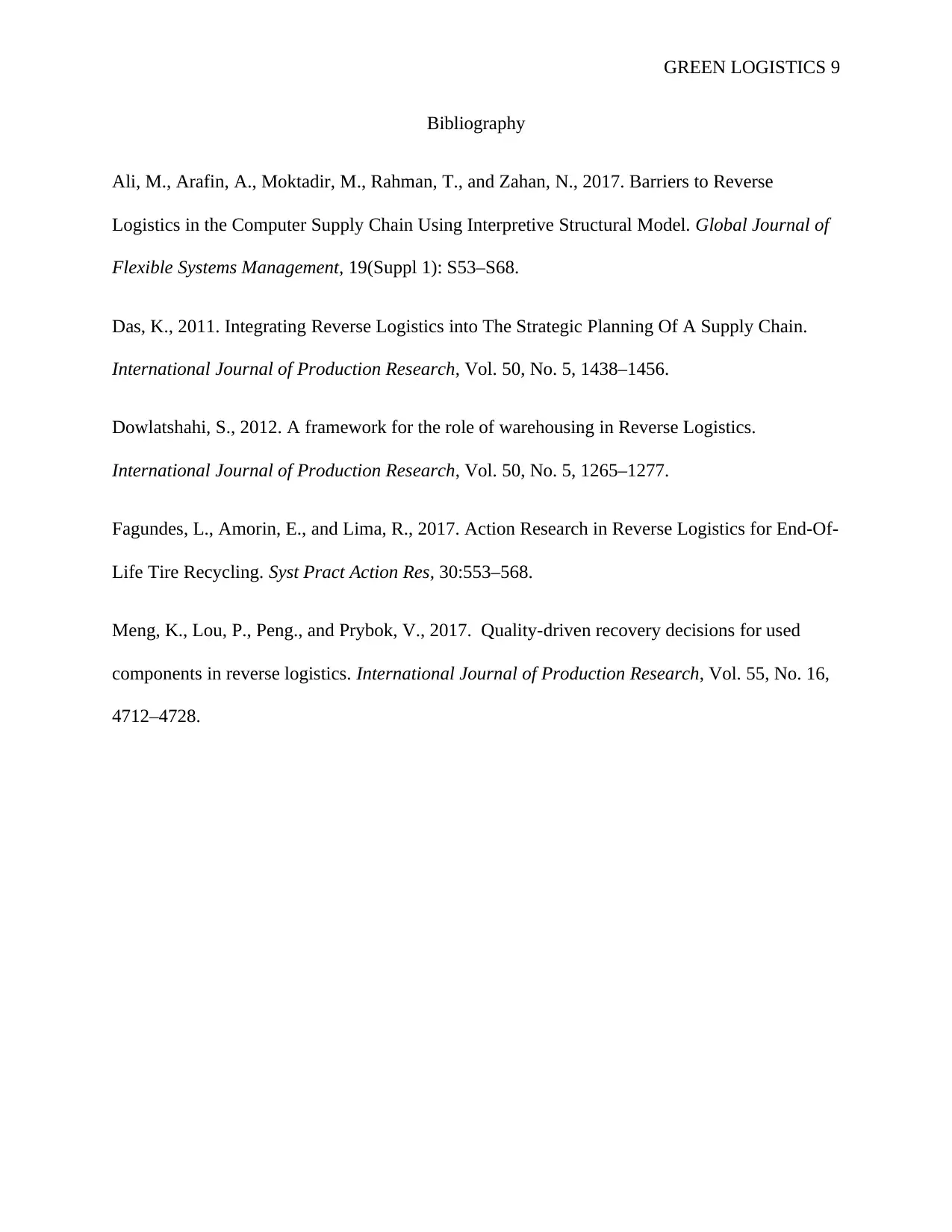
GREEN LOGISTICS 9
Bibliography
Ali, M., Arafin, A., Moktadir, M., Rahman, T., and Zahan, N., 2017. Barriers to Reverse
Logistics in the Computer Supply Chain Using Interpretive Structural Model. Global Journal of
Flexible Systems Management, 19(Suppl 1): S53–S68.
Das, K., 2011. Integrating Reverse Logistics into The Strategic Planning Of A Supply Chain.
International Journal of Production Research, Vol. 50, No. 5, 1438–1456.
Dowlatshahi, S., 2012. A framework for the role of warehousing in Reverse Logistics.
International Journal of Production Research, Vol. 50, No. 5, 1265–1277.
Fagundes, L., Amorin, E., and Lima, R., 2017. Action Research in Reverse Logistics for End-Of-
Life Tire Recycling. Syst Pract Action Res, 30:553–568.
Meng, K., Lou, P., Peng., and Prybok, V., 2017. Quality-driven recovery decisions for used
components in reverse logistics. International Journal of Production Research, Vol. 55, No. 16,
4712–4728.
Bibliography
Ali, M., Arafin, A., Moktadir, M., Rahman, T., and Zahan, N., 2017. Barriers to Reverse
Logistics in the Computer Supply Chain Using Interpretive Structural Model. Global Journal of
Flexible Systems Management, 19(Suppl 1): S53–S68.
Das, K., 2011. Integrating Reverse Logistics into The Strategic Planning Of A Supply Chain.
International Journal of Production Research, Vol. 50, No. 5, 1438–1456.
Dowlatshahi, S., 2012. A framework for the role of warehousing in Reverse Logistics.
International Journal of Production Research, Vol. 50, No. 5, 1265–1277.
Fagundes, L., Amorin, E., and Lima, R., 2017. Action Research in Reverse Logistics for End-Of-
Life Tire Recycling. Syst Pract Action Res, 30:553–568.
Meng, K., Lou, P., Peng., and Prybok, V., 2017. Quality-driven recovery decisions for used
components in reverse logistics. International Journal of Production Research, Vol. 55, No. 16,
4712–4728.
1 out of 9
Your All-in-One AI-Powered Toolkit for Academic Success.
+13062052269
info@desklib.com
Available 24*7 on WhatsApp / Email
![[object Object]](/_next/static/media/star-bottom.7253800d.svg)
Unlock your academic potential
© 2024 | Zucol Services PVT LTD | All rights reserved.





